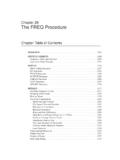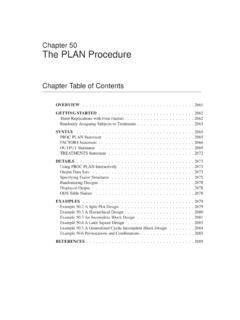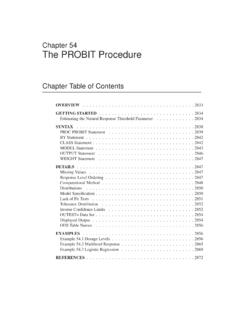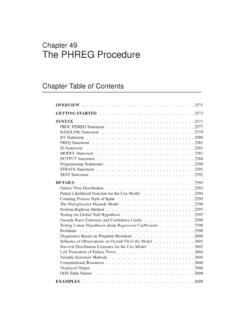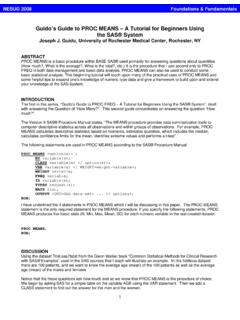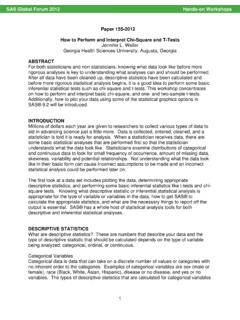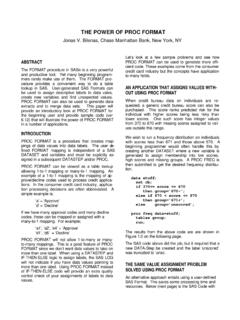Transcription of The SURVEYSELECT Procedure
1 Chapter 63. The SURVEYSELECT Procedure Chapter Table of Contents OVERVIEW .. 3275. GETTING STARTED .. 3276. Simple Random Sampling .. 3277. Stratified Sampling .. 3279. Stratified Sampling with Control Sorting .. 3282. SYNTAX .. 3283. PROC SURVEYSELECT Statement .. 3284. CONTROL Statement .. 3294. ID Statement .. 3295. SIZE Statement .. 3295. STRATA Statement .. 3295. DETAILS .. 3296. Missing Values .. 3296. Sorting by CONTROL Variables .. 3296. Sample Selection Methods .. 3297. Simple Random Sampling .. 3298. Unrestricted Random Sampling .. 3298. Systematic Random Sampling .. 3299. Sequential Random Sampling .. 3299. PPS Sampling without Replacement .. 3300. PPS Sampling with Replacement .. 3302.
2 PPS Systematic Sampling .. 3302. PPS Sequential Sampling .. 3303. Brewer's PPS Method .. 3304. Murthy's PPS Method .. 3305. Sampford's PPS Method .. 3306. Output Data Set .. 3306. Displayed Output .. 3309. ODS Table Names .. 3310. EXAMPLES .. 3310. Example Replicated Sampling .. 3310. Example PPS Selection of Two Units Per Stratum .. 3313. 3274 Chapter 63. The SURVEYSELECT Procedure Example PPS (Dollar-Unit) Sampling .. 3315. REFERENCES .. 3319. SAS OnlineDoc : Version 8. Chapter 63. The SURVEYSELECT Procedure Overview The SURVEYSELECT Procedure provides a variety of methods for selecting probability-based random samples. The Procedure can select a simple random sample or a sample according to a complex multistage sample design that includes stratifi- cation, clustering, and unequal probabilities of selection.
3 With probability sampling, each unit in the survey population has a known, positive probability of selection. This property of probability sampling avoids selection bias and enables you to use statistical theory to make valid inferences from the sample to the survey population. To select a sample with PROC SURVEYSELECT , you input a SAS data set that con- tains the sampling frame, or list of units from which the sample is to be selected. You also specify the selection method, the desired sample size or sampling rate, and other selection parameters. The SURVEYSELECT Procedure selects the sample, produc- ing an output data set that contains the selected units, their selection probabilities, and sampling weights.
4 When you are selecting a sample in multiple stages, you invoke the Procedure separately for each stage of selection, inputting the frame and selection parameters for each current stage. The SURVEYSELECT Procedure provides methods for both equal probability sam- pling and probability proportional to size (PPS) sampling. In equal probability sam- pling, each unit in the sampling frame, or in a stratum, has the same probability of being selected for the sample. In PPS sampling, a unit's selection probability is pro- portional to its size measure. For details on probability sampling methods, refer to Kish (1987, 1965), Kalton (1983), and Cochran (1977). The SURVEYSELECT Procedure provides the following equal probability sampling methods: simple random sampling unrestricted random sampling (with replacement).
5 Systematic random sampling sequential random sampling This Procedure also provides the following probability proportional to size (PPS). methods: PPS sampling without replacement PPS sampling with replacement 3276 Chapter 63. The SURVEYSELECT Procedure PPS systematic sampling PPS algorithms for selecting two units per stratum sequential PPS sampling with minimum replacement The Procedure uses fast, efficient algorithms for these sample selection methods. Thus, it performs well even for very large input data sets or sampling frames, which may occur in practice for large-scale sample surveys. The SURVEYSELECT Procedure can perform stratified sampling, selecting samples independently within the specified strata, or nonoverlapping subgroups of the survey population.
6 Stratification controls the distribution of the sample size in the strata. It is widely used in practice towards meeting a variety of survey objectives. For example, with stratification you can ensure adequate sample sizes for subgroups of interest, including small subgroups, or you can use stratification towards improving the precision of the overall estimates. When you are using a systematic or sequential selection method, the SURVEYSELECT Procedure also can sort by control variables within strata for the additional control of implicit stratification. The SURVEYSELECT Procedure provides replicated sampling, where the total sam- ple is composed of a set of replicates, each selected in the same way.
7 You can use replicated sampling to study variable nonsampling errors, such as variability in the results obtained by different interviewers. You can also use replication to compute standard errors for the combined sample estimates. Getting Started In this example, an Internet service provider wants to conduct a customer satisfaction survey. The survey population consists of the company's current subscribers. The company plans to select a sample of customers from this population, interview the selected customers, and then make inferences about the entire survey population from the sample data. The SAS data set Customers contains the sampling frame, which is the list of units in the survey population.
8 The sample of customers will be selected from this sam- pling frame. The data set Customers is constructed from the company's customer database. It contains one observation for each customer, with a total of 13,471 obser- vations. Figure displays the first ten observations of the data set Customers. SAS OnlineDoc : Version 8. Simple Random Sampling 3277. Internet Service Provider Customers (First 10 Observations). Obs CustomerID State Type Usage 1 416-87-4322 AL New 839. 2 288-13-9763 GA Old 224. 3 339-00-8654 GA Old 2451. 4 118-98-0542 GA New 349. 5 421-67-0342 FL New 562. 6 623-18-9201 SC New 68. 7 324-55-0324 FL Old 137. 8 832-90-2397 AL Old 1563. 9 586-45-0178 GA New 615. 10 801-24-5317 SC New 728.
9 Figure Customers Data Set (First 10 Observations). In the SAS data set Customers, the variable CustomerID uniquely identifies each customer. The variable State contains the state of the customer's address. The company has customers in the following four states: Georgia (GA), Alabama (AL), Florida (FL), and South Carolina (SC). The variable Type equals Old' if the cus- tomer has subscribed to the service for more than one year; otherwise, the variable Type equals New'. The variable Usage contains the customer's average monthly service usage, in minutes. The following sections illustrate the use of PROC SURVEYSELECT for probability sampling with three different designs for the customer satisfaction survey.
10 All three designs are one stage, with customers as the sampling units. The first design is simple random sampling without stratification. In the second design, customers are stratified by state and type, and the sample is selected by simple random sampling within strata. In the third design, customers are sorted within strata by usage, and the sample is selected by systematic random sampling within strata. Simple Random Sampling The following PROC SURVEYSELECT statements select a probability sample of customers from the Customers data set using simple random sampling. title1 'Customer Satisfaction Survey';. proc SURVEYSELECT data=Customers method=srs n=100. out=SampleSRS;. run;. The PROC SURVEYSELECT statement invokes the Procedure .
